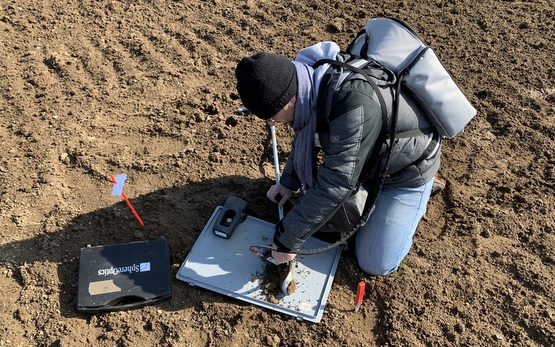A novel protocol for robust in-field monitoring of carbon stock and soil fertility based on proximal sensors and existing soil spectral libraries
Determining soil properties often requires lengthy and expensivelaboratory analysis. Soil spectroscopy is becoming an increasinglyaccepted technology, allowing rapid, cheap and high-resolution soil analysis based on the absorption of vis-NIR light (350–2500 nm) of soil constituents (mostly organic matter, clay minerals and metal oxides).
Spectral libraries have been developed based on processed soil samples (dried, ground) in the laboratory, and the challenge now is to transfer this technology to the field, where soils are less homogenous and problems arise due to changing moisture contents and soil structure. ProbeField will examine mathematical and physical methodologies to reduce the heterogeneity and noise of measurements and develop a best practice protocol.
As a first step, an overview of existing approaches to field scanning will be compiled from current literature and existing soil spectral libraries (SSL) will be collected. This will include an investigation of the best instrument and sample presentation for optimal scanning results in the field and the effects of different agricultural systems on spectral measurements.
Two different classes of vis-NIR spectrometers are used to investigate the best scanning position for field samples from different sites across Switzerland: one expensive research-grade portable spectrometer and one low-price miniature spectrometer with novel MEMS technology (Micro-Electro-Mechanical Systems). Both are used to scan the soil samples at different scanning positions, including scanning the sides of a core (0–20 cm) and the soil surface in different surface conditions. The resulting spectra were used as input for mathematical models to predict several soil parameters (i.e. clay, organic carbon, pH, cation exchange capacity, nutrients). Based on the model performances, it was decided to use the scanning position on the side of the core as the future standard approach. The next steps will be to test methodologies to mitigate the negative influence of moisture content and soil structure.
Project Partners
- SLU (SE)
- AU (DK)
- AGES (AT)
- AGS (CH)
- BOKU (AT)
- CNR (IT)
- CREA (IT)
- CSIC (ES)
- CZU (CZ)
- INRAE (FR)
- IUNG (PL)
- TAGEM (TR)
- UM-FKBV (SLO)
- WR (NL)






